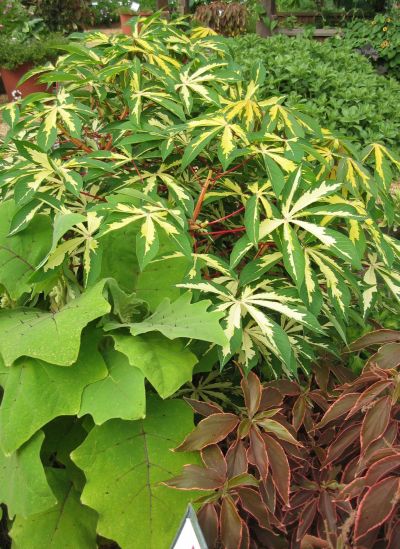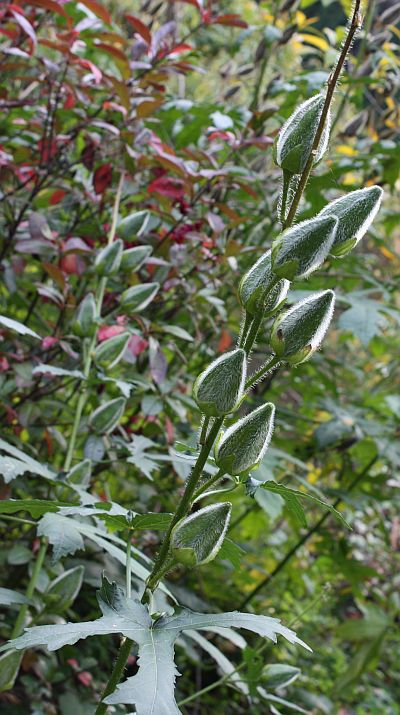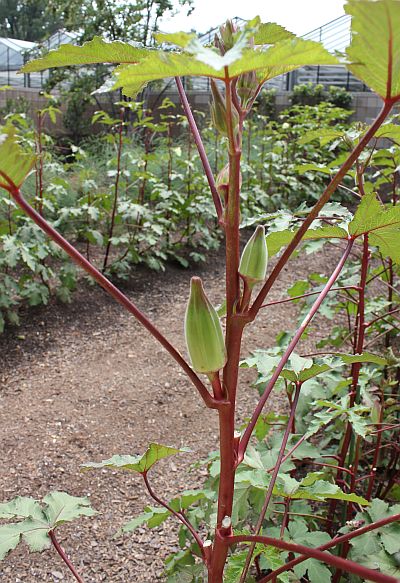I’ve been remiss in getting quizzes posted – partially a time issue, but mostly a lack of interesting photos. But I’ve got one today:

Can you identify what this plant is, and specifically what the little green candles are?
Answers on Monday!
There are lots of things that people write about that I strongly disagree with. Mostly I keep my mouth shut because my comments would amount to:
A. Preaching to the choir
B. Supporting the phrase "A man convinced against his will is of the same opinion still" (I’m not sure who to attribute this saying to — I’ve seen a few different authors named). My interpretation of this phrase is that you can’t convince someone of something they don’t want to be convinced of.
But I don’t feel that way with most of my colleagues — and I certainly don’t feel that way about any of my fellow bloggers. We feel, and have always felt (as far as I know) that it’s important for us to disagree openly on things because only through open discussion can we arrive at the truth. I also think that it’s important that you get to see our disagreements.
Too often the vision that I think most people have of academic discussions is of a bunch of jerky professor types sitting around a table in a pretty university conference room nodding to each other that, yes, yes, all academics agree and we must now force the public to believe what we do. If I’m being honest (and I try….) I sometimes feel the same way about topics like global warming. Sure, many academics agree that global warming has been brought on by humans, but it’s far from unanimous and you need to listen to all of the voices, not just the loudest ones, to get the whole story. Actually, there are relatively few topics that "all academics" agree on.
I am extremely proud of this website because it allows everyone to see the discussions that professional horticulturists have about various topics. Sure, often we agree, but sometimes we don’t. When we don’t agree we hash it out and admit when there isn’t research supporting our ideas. And we also talk about the research we conduct which is meant to give us answers — and reduce disagreements — such as Bert’s recent post requesting input on which experiment would be most valuable. All of his proposed experiments would provide answers to questions that we regularly discuss.
Which brings us to Linda’s most recent post. You can mark me down as being highly skeptical of washing the roots of B&B trees prior to planting. Linda obviously believes otherwise. We both have our reasons, and we both agree that more research needs to be conducted. Until it’s conducted we’ll just agree to disagree and get along with each other fine. And it’s a nice feeling to work in that kind of environment (Happy post this week — Next week I’m planning on some serious anger!).
At the tail end of August, we (the Hahn Horticulture Garden at Virginia Tech) hosted our second-ever all-day symposium. I christened it the Down ‘n’ Dirty Garden Symposium series – no stuffiness allowed! All fun, all useful info. This year we lured the fab Amy Stewart in as our anchor speaker. Quite the coup for our little town! My friend from grad school, Paula Gross, of the UNC-Charlotte Botanic Garden and co-author of "Bizarre Botanicals" brought her roadshow of wacky plants and action video. Karen Rexrode, northern Virginia gardener, photographer and artist, inspired us to explore the Dark Side of gardening.






I’m still smiling. And totally inspired. This symposium is going to be really, really hard to top.
p.s. Pardon the missed post, was in Hawaii. I’ll probably post about that experience a little later on, when I’ve fully recovered. I can’t speak for Bert and the mai tais – except they were $14 each at the wildly-overpriced Hilton resort hosting the conference. Doubt he had many…</d
This is a tale of three plants in my garden that would make the cruelest of multiple choice answers. Heh. Hence the inclusion of all three in this post:
a. Manihot esculenta
b. Abelmoschus manihot
c. Abelmoschus esculentus
d. All of the above
e. Aaaargh.
Manihot esculenta is Cassava or Tapioca; worthy of an entire post on its own. But the choice ornamental version is M. esculenta ‘Variegata’ or variegated tapioca. I first saw it (gawked and squealed, actually) at Allan Armitage’s fab trial garden at the University of Georgia. Full sun, hot as blue blazes – not the usual environment variegated plants thrive in. But this South American native loves it. It’s worked its way north in the trade; now nearly every plant nerd garden has it. Perfect in beds or containers, it makes a lovely, well-behaved clump in temperate zones – a big shrub in warmer areas. Interestingly, Manihot is in the Euphorbiaceae family; the other two are Malvaceae (hibiscus family). Hardy only to Zone 9, unfortunately.

Manihot at the UGA garden in 2004. Love those red stems!

In our home garden. A bit of a shady spot, hence the less-vivid coloration.
Abelmoschus manihot is variously known as sweet hibiscus, sunset hibiscus, etc. and remains rather obscure. It’s easy to grow from seed, plus reseeds gently where happy (like the gravel paths in our kitchen garden). Not much to look at until late summer, then the big lemon-yellow flowers unfurl – usually one or two at a time on each plant. The seed pods march up the stem, resembling a smaller version of okra. Gets tall – up to 6’ or so – but the sturdy stems don’t need staking. Collect seeds from the dried pods to start next year.

The foliage is edible – I’ve gnawed a leaf or two but was underwhelmed. Maybe in soup.

The flower of Abelmoschus manihot is very similar to but a bit larger than those of okra…

Marvelous pods in the fall at Chanticleer.
Finally, the most common – Abelmoschus esculentus – Okra. Hitting its stride right now in the home garden. Extremely ornamental, especially the red-stemmed varieties.

Okra ‘Hill Country Red’ at the Atlanta Botanical Garden this summer. Gorgeous!

The important bits.
Okra is a very unique veg. You may be cringing from some past okra mishap, but I urge you to try it 1) fresh and 2) prepared correctly. Yes, it’s a bit mucilaginous, but what makes it gooey also serves a wonderful thickener for gumbo, stews, and the like. Pickled okra makes an exceptional cocktail garnish for vodka martinis (add a splash of hot sauce for a Cajuntini). I love okra dearly but never buy it in the store – as it sits around, the pods become woody and tough. Try it fresh from the farmer’s market or even better, the back yard. Not trying add to the food-blog-saturation point, but please allow me to wander off-topic and share my favorite fried okra recipe. The deep-fried, breading-buried stuff normally sold as
fried okra is far, far inferior.
Holly’s Fried Okra
(Materials and Methods)
Pick a mess* of okra. Slice up your pods (no more than ¼” to 1/3″ sections. If it’s difficult to slice, discard that pod – too old/tough) and toss into a bowl with a sploosh of buttermilk, just enough to moisten it. Add salt, pepper, and a dash of cayenne. Stir gently. Get a big fry pan or wok (okra needs its space) and heat some veg or olive oil. Not a lot, just a few tablespoons. Don’t let oil get smokin’ hot, don’t want to burn it. Now throw a big handful of cornmeal into the bowl with the okra and stir gently again. Some will stick, some won’t. You should be able to see the okra, not just blobs of coating. Move okra to hot pan with a slotted spoon, giving it a shake over the bowl so you don’t get a lot of extra cornmeal in the pan. Just enough for one layer – don’t crowd the pan or it will be soggy. Toss gently over medium heat for about 5 to 8 minutes until some corners are very dark brown and crispy and everything else is either green or golden. Remove to paper towel-covered plate; add a dusting of kosher salt, then start the next batch (replication). Eat the first batch while standing there making the second batch. Helpers will magically appear. The first batch NEVER makes it to the table in our house.
Crispy, non-greasy, okra goodness!
*mess = “as much as you need for your meal”, be it for two or ten. This recipe uses about three cups of slices – though can’t say I’ve ever measured. Enough to feed two or three (two if they really like it). Adjust other ingredients accordingly.
School starts next week and so time is short, but I have a few quick thoughts to share with you before I get back to setting up class for next semester:
1. A class called Plant Production appears to be more attractive to students than a class called Nursery Management and Production — even though the concepts taught are essentially the same.
2. One of the greatest movies of all time, Caddyshack, includes a scene with milorganite. I won’t tell you which scene so that you can discover for yourself!
3. Yes, that is what I did during my vacation — watched Caddyshack.
4. The paint company Sherwin Williams used to sell insecticides in the early 1900s and late 1800s — things like lead arsinate and Paris green — and they used the same logo to advertise these insecticides that they use for their paints today — go ahead, look it up — and then tell me, if you were a PR person for a pesticide firm would you use that logo?
5. The peanuts are so close to being ripe I can almost taste them!
6. There’s nothing quite as good as eating Dunkin Donuts and scrapple for breakfast (I spent the past week in Southeast PA — my hometown — and one of the few places that you can find scrapple).
About two weeks ago a reader (Julie) e-mailed me about some young gardeners/farmers and how they believed in a natural balance. The e-mail read: “Would you mind devoting a blog or two to the philosophy that nature is perfectly balanced and will find a solution to whatever ails it and therefore we do not need to use any chemicals or poisons to fight pests and disease?”
I thought this was a good question, and here’s my quick answer (followed, naturally, by a more long and drawn out answer). Yes, I do believe that nature will strike its own balance. Unfortunately this balance won’t always be great for humans.
The more in-depth explanation…..Organisms like diseases, plants and animals do what they have evolved to do. The plants grow, the insects feed on them, the insect poo goes back into the ground. The insects get eaten by an animal and then that animal’s poo goes back into the ground – the tree uses the poo as fertilizer — it’s all a big cycle and it works. If any particular plant or insect gets out of hand then invariably something that eats it will eventually show up and go gangbusters — and all of it goes back to the ground.
For humans who “live off the land” this balance works fine. They’re not looking for huge yields of food per acre, and they’re willing to forgo certain foods if that food happens to be in short stock in a particular forest in a particular year because of an insect or disease or whatever. And so insect or disease losses will usually leave them plenty of food to eat. But modern agriculture is based on large yields per unit area. That means that the whole balance thing goes out the window. Likewise, because humans prefer non-blemished food, the whole balance thing gets screwed up too. So, in the end, we usually end up doing something to get rid of pests.
And then there’s fertility to consider — When we grow crops on a piece of land we take whatever is produced and then eat it or sell it – but rarely do we put our waste back on that land. What that means is that we’re fighting the balance. By not recycling our waste we’re taking from the land without returning what we took from it back to it. So, after a few years, we end up having to fertilize because the land just can’t make up for what we’ve taken and not returned.
Balance is great – I just think that it’s tough to strike a balance with modern agriculture and still feed ourselves.
So, there you have it – my two cents on balance.
[Warning: pointless post/ramblings]
Actually it was a "staycation." We usually scoot to the Caribbean for a week. I’d like to say this was better.* Though home from our regular jobs for a week, we worked like fiends. Our primary target was the multitude of Autumn Olive (exotic invasive) and Sycamore (native yet ridiculously prolific) taking over a nice four-acre field. We we don’t quite know what to do with this creek bottom, except to not let it grow up into a monoculture (biculture?) of 14′ tall Eleagnus and Sycamore. Our local rental joint delivered a spankin’ new JCB backhoe/frontloader last Monday, and fun was had. I have a thing for heavy equipment, and don’t stink with a Bobcat. But this was bigger than I was expecting.
To familiarize myself with the backhoe, I started out with a planting hole for a 15-gallon tree. Oh, what Linda would have given for a picture of resulting crevasse."Dig hole 1000 x the width and 6000x the depth of the rootball." Whoops. Could have planted a minivan. Took a bit of time to fill it back up to the point the entire tree wasn’t below ground. But I got better. After several days, I was ripping out invasive species with surgical (ha!) precision. Take that! Very gratifying.

The JCB 3CX with "EcoDig." Advertised as 18% more fuel efficient, so I’m helping the earth while I tear s*** up.
Then Joel surprised me with a truckload of mulch (Squee! Nothing says "I love you" like 4.5 cubic yards of shredded bark). With Bert’s recent post in mind, I proceeded to "check the mulch for the presence of a foul or pungent odor." My snort-inhalation was perhaps too close to the pile as the fine bits of mulch went up my nose like it was 1985. I did detect some volatile compounds as my eyes watered and the sneezing commenced. It was still a bit warm, so was careful not to get it too close to the plants. Not that there was much "tender" tissue since it hasn’t rained here in eons. Will report back if I’ve ruined the bed.

Truckload o’ love. And yes, our "Farm Use" plate is held on by duct tape.
*Nope. Wasn’t.
</d
Can’t get anything past our blog readers! Yes, from the highly cropped photo on Friday two readers quickly recognized emerging Indian pipe (Monotropa uniflora):

These plants have no chlorophyll, instead relying on fungal partners who colonize both their roots and the roots of nearby photosynthetic plants. So ultimately this is a parasitic species, as it takes resources from the photosynthesizers in its root network without reciprocal benefit.
These are not commonly found plants, so I think it’s really cool that they appeared in such profusion in a home landscape.